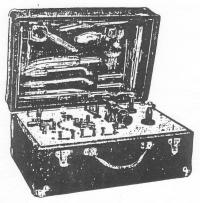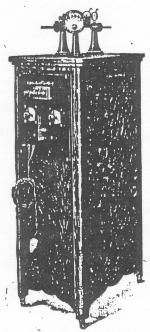


Let us call the line zero in volts and the crest of the
wave 110 volts. The current starts at zero, reaches the maximum positive
voltage and then reverses and goes back to zero and repeats on the negative
side. This complete reversal of the current is called an alternation and
two of them make a cycle. If we only represented two alternations as in
Fig. 4 and then made the second one return to the starting point as shown
by the dotted line we would have in this case a circle, and the word circle
will keep the meaning of cycle fixed in the mind. Alternations do not necessarily
assume the shape of a semi-circle but may represent any form of wave, still
two of them represent the completion of the circuit or cycle. In high frequency
currents these cycles become a succession of oscillations or undulation
as represented graphically in Fig. 3.
Frequency is a term properly belonging only to the alternating
current. We have uni-directional currents such as those derived from induction
coils, in which the current is broken up into a rapid series of waves,
with those which would be below the line damped out, leaving a succession
of pulsations. This current lights up vacuum tubes and performs much of
the same work as the high frequency, but is not a true high frequency current.
These are called pulsatory currents and in place of the
word frequency we indicate their rapidity by the term periodicity.
To return to our explanation of the alternating current
let us suppose that it takes one-one hundred and twentieth of a second
for any one of the alternations in Fig. 3. Then two alternations or one
cycle would take two times one-one hundred and twentieth, which equals
one-sixtieth of a second, and this is the period of the current illustrated.
If it takes one-sixtieth of a second for one cycle, there will be sixty
times as many in one second, and this is the frequency.



The absence of pain is supposed to be due to the inability
of the sensory nerves to comprehend such rapid alternations just as we
have vibrations that cannot be recognized by the auditory nerve as sound
or by the eye as light.
In these higher frequencies the contractile effect is
expended upon the individual cells making up the tissues instead of on
individual muscles. This I call cellular massage and it is one important
reason why high frequency currents produce such a marked benefit on nutrition
and metabolism.
As the current increases in frequency and voltage, other
peculiarities appear and it no longer requires a complete metallic circuit
but is capable of traversing long distances as ether waves as in the wireless
telegraph. In fact, high frequency currents are better understood as vibrations
than as ordinary currents.
From the fact that muscular contractions cease with 10,000
cycles or oscillations, this has been taken as the dividing line between
medium and high frequency currents.
As the frequency with some apparatus is estimated in millions,
I ave been advocating a higher dividing line, say 100,000, as more in proportion,
but this would cause considerable confusion at present and so the original
nomenclature is adhered to.
Lighting of Vacuum tube Not Proof of High Frequency Current.
As intimated above, exciting a vacuum tube as from the static machine or
from one terminal of an induction coil is not proof of the presence of
a high frequency current. To produce the high frequency current there must
be attached to either of the above one of the several forms of high frequency
apparatus described in Chapter III.
